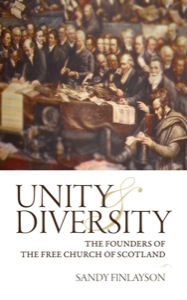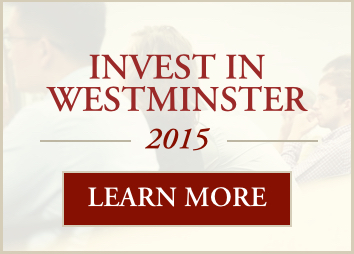|
|
Finlayson on Reformed ForumSeptember 19, 2011
The Founders of the Free Church of Scotland Mr. Sandy Finlayson, professor of theological bibliography and director of library services, was recently featured on the Reformed Forum show "Christ the Center." Mr. Finlayson was there to talk about his book, Unity & Diversity: The Founders of the Free Church of Scotland. The book is a wonderful perspective of the history of the Free Church as it presents stimulating and readable biographies of many key figuressurrounding the founding of the Free Church of Scotland. Joining him on the show were Camden Bucey (MDiv '11) and Rev. Dr. Carl Trueman. Click here to listen to the program. Partial transcript:Bucey: The book we're speaking of here today is Unity & Diversity: The Founders of the Free Church of Scotland by Sandy Finlayson. It's by Christian Focus publications. It's a wonderful book. Not only is it put together well and is a pleasure to read, but also it has many wonderful illustrations and pictures of the founders of the free church! It's a wonderful history and a delight to read, and it's a compilation of ten short biographies of some of these key figures and we're going march through some of them today. Dr. Trueman, I'll let you open things up. As we set the scene, what are some of the cultural contexts and ecclesiastical contexts surrounding the whole events of the beginnings of the Free Church of Scotland? Dr. Trueman: Sandy will be able to put far more flesh on the bones than I can, but essentially, the Church of Scotland divided in 1843 on the issue of patronage: who had the right to call a minister. The active union between England and Scotland in 1707 had made it clear that the Scottish Presbyterian system whereby patronage, the Anglican way of calling a pastor, would not be allowed in Scotland. This was overruled by the patronage act of 1712, which then set up about 130 years of a long legal discussion on the status of the rights of the congregation as opposed to land-owners to call ministers to congregatoins. In the 1830's, this issue came to a head, and a group led by Thomas Chalmers fought for the rights of congregations within the church, and in 1843, when all legal avenues had been closed down, it led to the Disruption: effectively a separation from the established Church of Scotland which formed the Free Church of Scotland. Culturally (and I'll just throw this out as an observation) it is interesting to note that many mainline protestant denominations in Europe split in the 1830's and 1840's. So there are clear cultural and social tensions, as well as theological tensions driving this. Things like the Oxford movement in the Anglican Church, the Afscheiding of the Dutch Reformed Church, and also a split happening in Switzerland. Bucey: Sandy, can you help our listeners understand a little bit about the 'establishment principle': what that is, and maybe what its significance is for our understanding of ecclesiology? Finlayson: The establishment principle is essentially the belief that there is a direct link between the church and the state. What it involves is making legal provision for the support of religious ministries by the state. Now, lest we think that this is a totally bizarre idea, we need to remember that this was formulated in the Westminster Confession of Faith. In the original formation of the Westminster Confession, chapter 23 section 3, there is an explicit statement that it is the duty of the civil magistrate to support the church. So virtually everyone in Scotland believed and accepted this principle: that there should be a link between the church and the state and that it was the duty of the state to provide for the needs of the church. In the American context, the American church revised the Westminster Confessions in 1788 to remove the establishment principle. But, at the time that we're talking about here, there was this direct link, and I think it is good for Presbyterians to remember that it does come directly from the Westminster Confession. ... Bucey: Let's speak about the right of patronage and the Veto Act as we set the stage for many of these great figures we're going to speaking about. What are those two things, and what is their significance in causing or bringing about this disruption? Finlayson: Well, as Carl has already mentioned, under patronage the way ministers were placed in parishes was by appointment by the local landowner, sometimes by the local counsel if they were in towns. As the Church of Scotland enters the 19th century, however, evangelicals within the church are expressing real concern over the spiritual independence of the church because, as much as the establishment principle says that there is to be a link between the church and the state, if you look at the original language of the Westminster Confession of Faith on this they make it very clear that the church is to be spiritually independent. So, in the 19th century, the Church of Scotland evangelicals are arguing that the church had the sole right to decide matters that had to do with spiritual matters within the church, and particularly appointment of ministers. So in 1834, the Church of Scotland actually passes something called the 'Veto Act.' The Veto Act was an attempt to restrict the power of patronage by giving to male heads of families the right to veto the parish patron's appointment of a minister. So that was an attempt on the part of the evangelicals within Church of Scotland to reform the system. Bucey: Was this a 'blackball' situation, or was there a majority vote? How did they weigh these vetoes? Finlayson: Well, what they said was that in order for a minister to be appointed to a parish and ordained or installed by the presbytery, he had to have a majority vote of male heads of familes. The name was proposed by the patron, but the congregation had the right under this act to say "No, we don't think this is the right man for us." In reality, there were many situations where there was good cooperation between patrons and parishes. In many circumstances, these things were worked out informally, but it was becoming increasingly difficult to do that. So, the Church of Scotland passes the Veto Act in 1984, and there's an immediate test of it. There's a parish in Perthshire where, out of a total of 336 heads of family, only two of them agreed to the appointment of the minister. So, when the presbytery got this information, they refused to ordain the man, and then he sued. He took the presbytery to court, and the courts found in his favor, and the courts directed that he be ordained and installed in the parish. Now, ultimately it took a long time for this to work its way through the courts, and he was actually not installed in the parish until after the Disruption; he wasn't installed until 1843. So that was the first test. Then, between 1834 and 1843 came to be known as the Ten Years Conflict. There were a series of these situations which escalated, and ultimately took the Church of Scotland in the direction to where the Disruption happened in 1843. I think it's important to note here that when the Disruption took place in 1843, the Church of Scotland lost a significant number of men. They lost 470 ministers, 192 candidates for the ministry, and the entire missionary force of the church. So all of the missionaries decided that they would leave the church of Scotland and go to the Free Church, which had a real impact on the subsequent outlook of the [Free] church, which was very evangelistic and missionary-minded. Click here to listen to the complete program, or click here to order a copy of Unity and Diversity at the Westminster bookstore.
|






